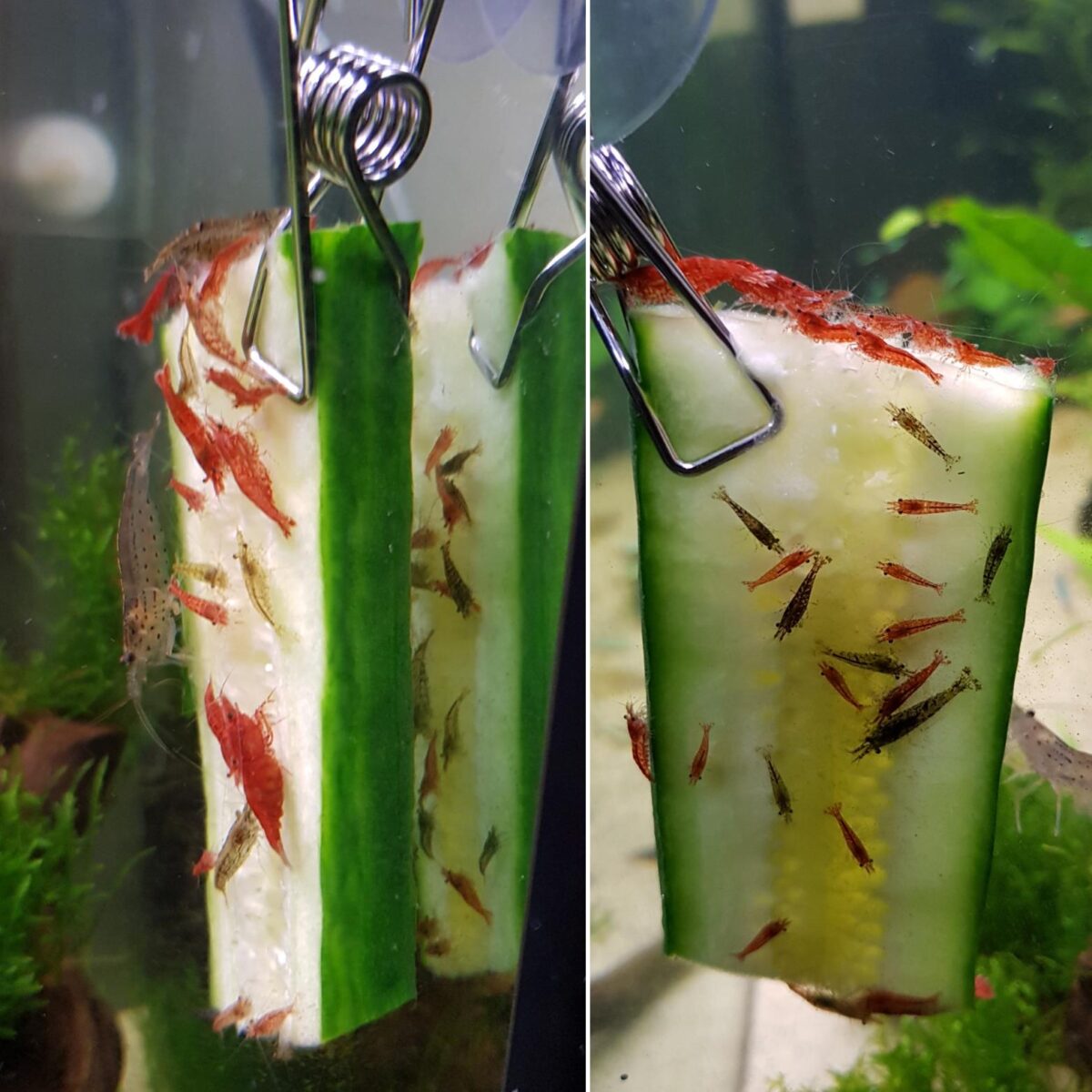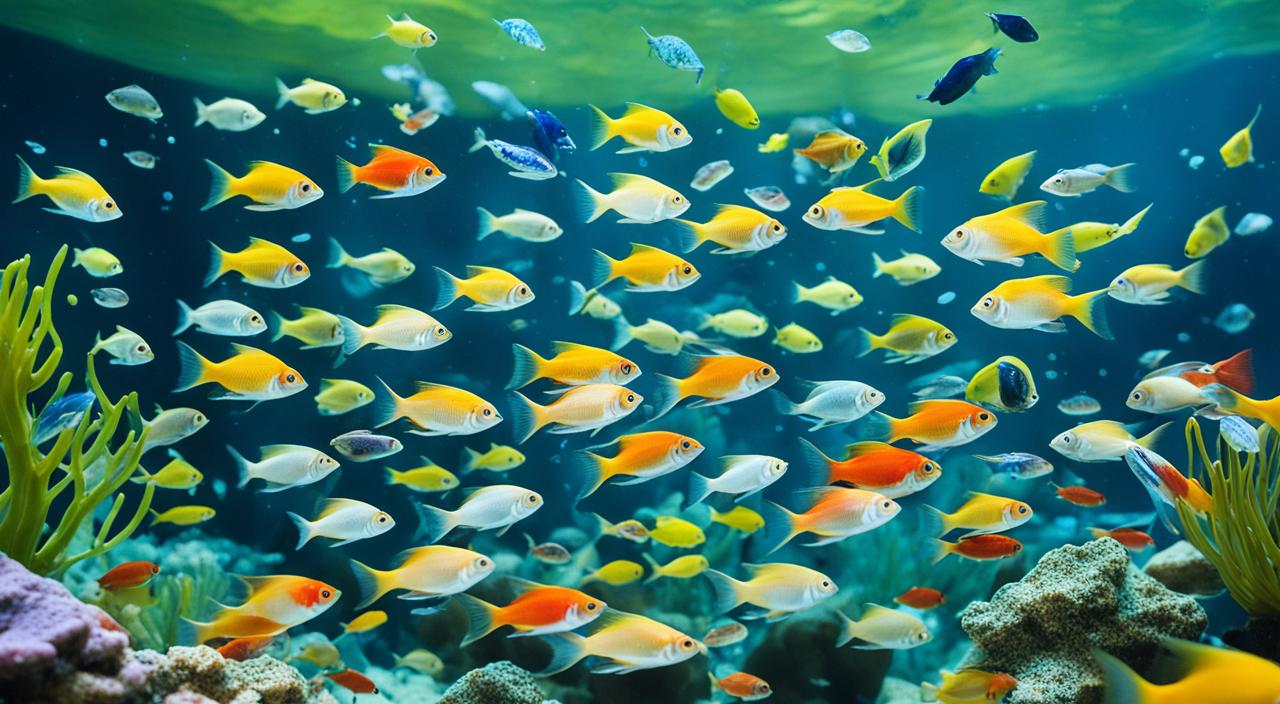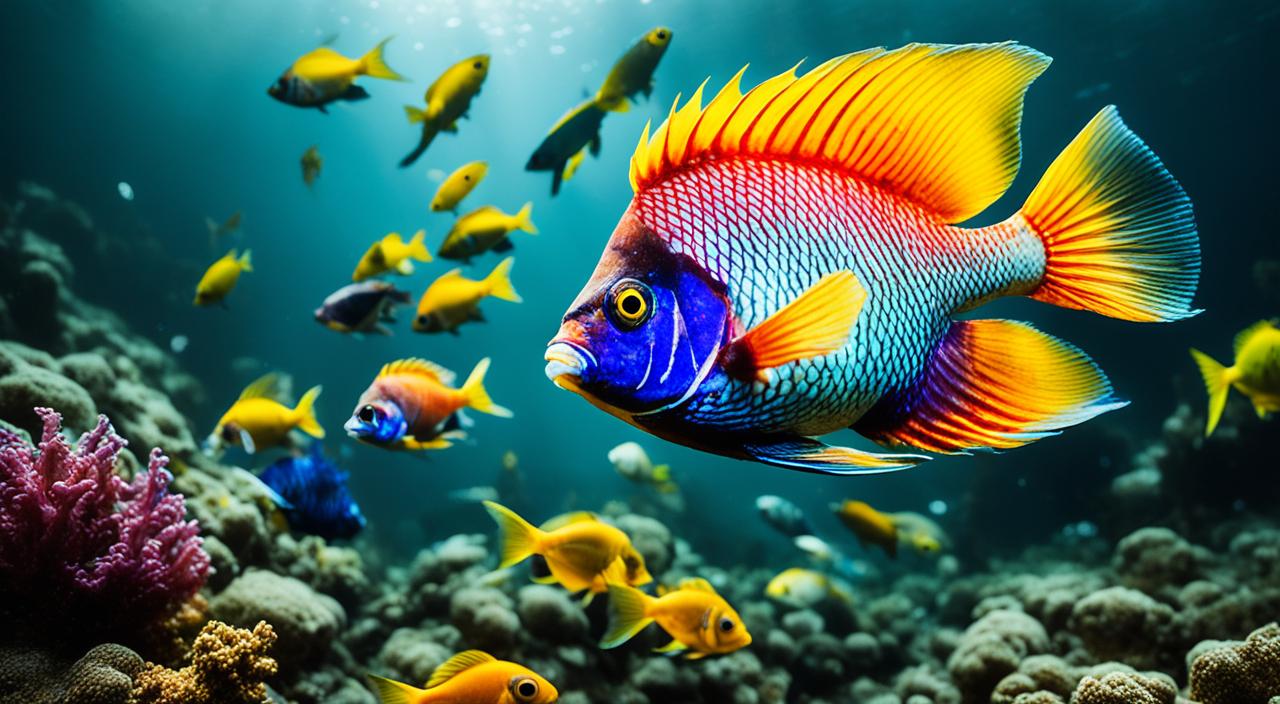When keeping aquarium shrimp, one key consideration is their diet. What do shrimp eat to thrive and remain healthy? Understanding their dietary preferences and providing the best food options is crucial for their well-being.
Shrimp play a vital role in maintaining the balance of the aquarium ecosystem. They help control water quality by consuming leftover fish food and dead plant parts. But what do they feed on in their natural habitat?
In the wild, shrimp have diverse feeding habits. They feed on muck, dead fish, carrion, and droppings. In addition to these scavenged food sources, they also graze on algae films and microbial biofilms using their bristled claws to scrape off food particles.
In an aquarium with well-fed fish, the presence of shrimp can reduce the need for supplementary feeding. However, providing additional food sources is essential for proper nutrition and health. For example, adding brown, dry autumn leaves to the aquarium can mimic the fallen leaves found in their natural habitats, which shrimp feed on.
Key Takeaways:
- Shrimp play a crucial role in maintaining water quality in the aquarium ecosystem.
- Shrimp feed on muck, dead fish, carrion, and droppings in their natural habitat.
- Shrimp graze on algae films and microbial biofilms using their bristled claws.
- The presence of shrimp in an aquarium with well-fed fish can reduce the need for supplementary feeding.
- Adding brown, dry autumn leaves to the aquarium can provide additional food for shrimp.
The Integral Role of Shrimp in Aquarium Ecosystems
Shrimp play a crucial role in maintaining a healthy aquarium ecosystem. They contribute to the cleanliness of the tank by consuming leftover food and organic waste, which helps maintain water quality. Additionally, shrimp help control algae growth by grazing on algae films and biofilms, preventing the overgrowth of unwanted algae.
Moreover, shrimp create a diverse ecosystem within the aquarium, contributing to its balance. Their presence helps prevent the population explosion of unwanted snails, keeping the aquarium environment in check.
Overall, shrimp are integral to the stability and health of an aquarium ecosystem, making them a valuable addition for any aquarium enthusiast.
What do Aquarium Shrimp Eat?
Natural Shrimp Feeding Habits
Shrimp have natural feeding habits that are important to understand to provide them with a healthy diet in an aquarium setting. They are scavengers and will eat a variety of organic matter. They feed on dead plant parts, muck, carrion, and even fish droppings in their natural habitat. Shrimp are also known to graze on algae films and microbial biofilms, using their bristled claws to scrape off food particles.
Optimal Conditions for Shrimp Grazing
To ensure that shrimp exhibit their natural feeding behaviour and consume their preferred food sources, creating optimal grazing conditions in the aquarium is essential.
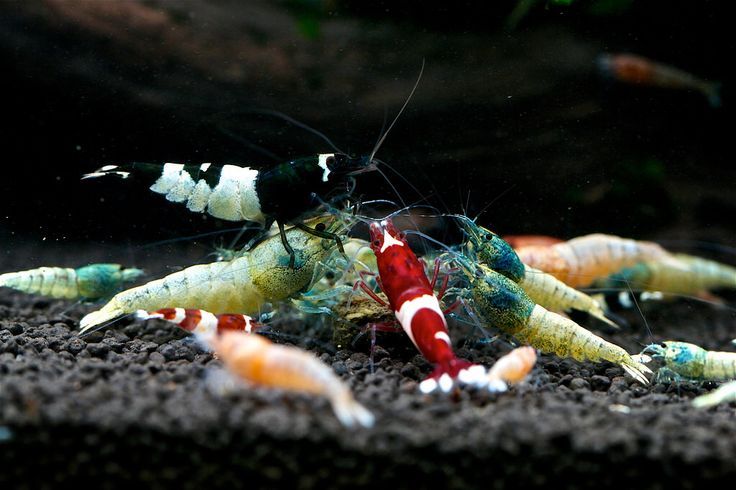
This can be achieved by providing a suitable substrate, such as fine sand or gravel, where algae films and biofilms can develop. It is also beneficial to have a well-established ecosystem with live plants and other organisms that contribute to the growth of these microorganisms. Additionally, maintaining water parameters such as temperature, pH, and hardness within the preferred range for shrimp species can support their grazing activities.
Preparing the Perfect Shrimp Diet
Understanding Freshwater Shrimp Dietary Needs
Understanding freshwater shrimp’s dietary needs is crucial to their health and vitality. These fascinating creatures require a balanced diet encompassing vegetable matter and protein sources. Like humans, they need various nutrients, including carbohydrates, proteins, fats, vitamins, and minerals, to support their growth and overall well-being.
While shrimp are natural scavengers and will eat almost anything that provides nutrients, they must have a well-rounded diet that meets their nutritional requirements. This will help them thrive in your aquarium and display their vibrant colours and active behaviour.
Choosing the Right Foods for Your Shrimp
When selecting food for your shrimp, choosing options that provide the necessary nutrients without compromising their health is vital. Consider incorporating a mix of commercial shrimp food and homemade meals into their diet to offer various nutrients and flavours.
Commercial shrimp food products are formulated specifically to meet shrimp’s dietary needs. Look for options that contain high-quality ingredients, such as spirulina, algae, and other natural food sources. Avoid foods with excessive fillers or low-quality protein sources, as these can harm shrimp’s health.
Alternatively, you can create homemade shrimp meals using natural ingredients. Fresh vegetables like spinach and nettle can provide essential greens for your shrimp, while other ingredients like kuri squash or zucchini can add variety to their diet. By using natural ingredients, you can ensure that your shrimp receives optimal nutrition while avoiding any potentially harmful additives.
| Vegetable Matter | Protein Sources |
|---|---|
| Fresh vegetables (spinach, nettle, etc.) | Commercial shrimp food |
| Brown dry autumn leaves | Frozen or live food (brine shrimp, daphnia, etc.) |
| Algae wafers or pellets | Homemade shrimp meals |
A well-balanced diet incorporating both vegetable matter and protein sources ensures your shrimp receive the nutrients they need to thrive in their aquatic environment. Remember to observe their feeding behaviour and adjust the amount of food accordingly to avoid overfeeding and maintain water quality.
DIY Shrimp Food: Benefits of Homemade Meals
Nothing beats homemade meals for providing the best nutrition for your aquarium shrimp. DIY shrimp food utilises natural, nutrient-rich ingredients that can support your health and vitality. By creating your shrimp delicacies, you have complete control over the quality and variety of ingredients, ensuring your shrimp receives a well-balanced diet.
Utilizing Natural Ingredients for Shrimp Nutrition
One advantage of homemade shrimp meals is the ability to incorporate natural ingredients. Fresh vegetables like spinach and nettle can provide essential green food for your shrimp. These vegetables are packed with vitamins and minerals that promote overall shrimp health. Additionally, you can add variety to your shrimp’s diet by including other natural ingredients like kuri squash or zucchini.
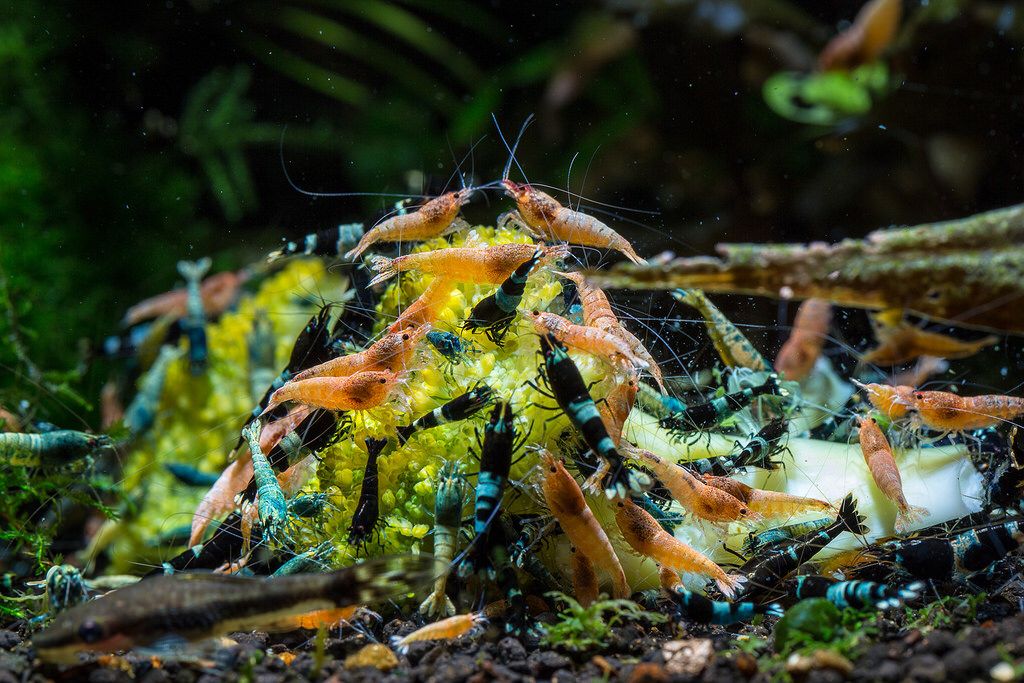
Natural ingredients can enhance shrimp food’s nutritional value and provide your aquarium inhabitants with diverse nutrients.
Instructions for Creating Homemade Shrimp Delicacies
Crafting your shrimp food is a straightforward process that allows you to cater to the specific dietary needs of your shrimp. Begin by selecting a variety of fresh vegetables and protein sources. Vegetables like spinach, nettle, kuri squash, and zucchini can be steamed or blanched to make them more suitable for shrimp consumption.
Next, consider adding protein sources such as mosquito larvae, daphnia, or brine shrimp. These protein-rich foods can be prepared separately and added to the vegetable base to create a well-rounded shrimp meal. Ensure that all ingredients are free from chemicals or pesticides.
Once you have prepared the individual ingredients, you can mix them in the desired ratios and portion them according to the size and number of your shrimp. Feeding your shrimp small amounts of food once or twice a day is essential to prevent overfeeding and water pollution.
Following these instructions, you can prepare homemade meals tailored to your shrimp’s nutritional needs, promoting their overall health and well-being.
Commercial Shrimp Food: What to Look For
Analyzing Ingredients for Shrimp Health
When choosing the right commercial shrimp food for your aquarium, it’s essential to analyze the ingredients to ensure the best possible nutrition for your shrimp. By carefully considering the ingredients, you can provide a balanced and healthy diet that supports their growth and overall well-being.
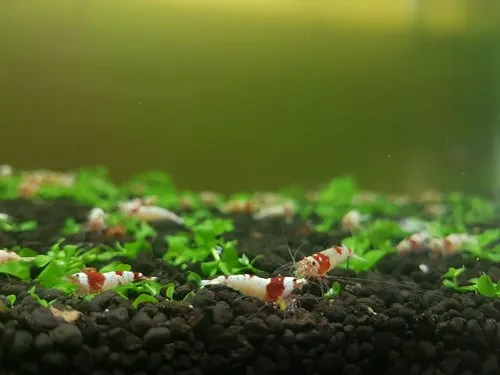
The key to selecting high-quality shrimp food is to choose products that contain natural and nutritious ingredients. Avoid foods with excessive fillers or rely on low-quality protein sources, as these may not provide the required nutrients for optimal shrimp health. Instead, look for shrimp foods that contain quality protein sources, such as fish meal or spirulina.
By carefully considering the pros and cons of different shrimp foods, you can choose the one that best meets the specific dietary needs of the species you are keeping. Remember that individual shrimp may have preferences, so finding the ideal commercial food for your aquarium may take trial and error.
Feeding Guide for Shrimp: Dos and Don’ts
How Often and How Much to Feed Your Shrimp
Feeding your shrimp the right amount and at the right frequency is crucial for their health and well-being. Here are some dos and don’ts to keep in mind:
- Feed your shrimp small amounts of food once or twice daily, depending on their activity levels. This helps ensure that they have enough to eat without overfeeding.
- Offer a variety of foods to provide a balanced diet. These can include commercial shrimp food, homemade meals, and natural sources of nutrition.
- Monitor your shrimp’s feeding behaviour to determine if they are consuming the food you provide. Adjust the amount of food accordingly to avoid wastage and potential water pollution.
- Avoid overfeeding, as excess food can pollute the water and cause unhealthy shrimp. Uneaten food can also decompose and imbalance the tank’s water parameters.
- Remove any uneaten food after a few hours to maintain water quality. This helps prevent the food from decaying and causing issues within the aquarium.
Observing Shrimp Feeding Behavior for Healthier Shrimp
Observing your shrimp’s feeding behaviour can provide valuable insights into their health and well-being. Here are some tips:
- Watch how actively your shrimp are feeding. Healthy shrimp will eagerly consume food while lacking interest in feeding may indicate a potential health issue.
- Note any changes in appetite. Sudden loss of appetite or excessive feeding can indicate stress, illness, or incorrect water parameters.
- Observe the shrimp’s grazing behaviour. Shrimp are natural grazers; observing their habits can help ensure access to the necessary food sources within the tank.
- Pay attention to abnormal behaviour, such as lethargy, aggression, or unusual swimming patterns. These can be signs of underlying health issues affecting their feeding.
Following these feeding guidelines and observing your shrimp’s behaviour can help maintain their health and promote their overall well-being.
Conclusion
A varied and balanced diet is crucial for maintaining aquarium shrimp’s health and well-being. Understanding their natural feeding habits and providing appropriate foods can ensure their optimal growth and vitality. Whether you choose commercial shrimp foods or homemade meals, prioritizing nutrition and quality ingredients is critical.
Regularly monitoring shrimp feeding behaviour is essential to identifying potential health issues and allowing for prompt intervention. Observing how much and how often you feed your shrimp can prevent overfeeding, leading to water pollution and unhealthy shrimp. Adjusting the amount of food according to their activity levels will help keep them healthy and thriving.
Remember, a varied diet that includes vegetable matter and protein sources is necessary to support shrimp’s growth and health. Whether incorporating fresh vegetables into their meals or choosing commercial shrimp foods with natural and nutritious ingredients, providing a well-rounded diet is crucial for their overall well-being.

